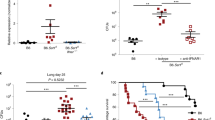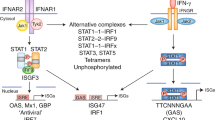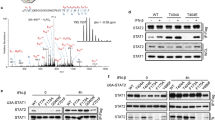Abstract
Type I interferons (IFN) are widely used for the therapeutic treatment of viral infections, tumor growth and various chronic diseases such as multiple sclerosis. Antagonism between type I IFNs and IFN-γ has been described in cells of the immune system, in particular in the activation of macrophages. To study the systemic effects of type I IFNs we used transgenic mice carrying a human IFN-β (hIFN-β) gene under the control of the rat insulin I promoter. These animals expressed high levels of hIFN-β in β-pancreatic cells, and the ability of the macrophages to respond to pro-inflammatory stimuli was analyzed. Transgenic mice exhibited an increased extravasation of cells to the peritoneal cavity after eliciting with thioglycollate broth. The expression of the inducible form of nitric oxide synthase and cyclooxygenase-2, two enzymes involved in inflammation, was impaired in transgenic animals challenged with lipopolysaccharide and IFN-γ. Analysis of the mechanisms leading to this attenuated inflammatory response showed a decrease in the serum levels of TNF-α and an inhibition of the activation of the transcription factor NF-κB in various tissues. These results indicate that systemic administration of IFN-β might influence the response to pro-inflammatory stimuli, in particular through the antagonism of IFN-γ signaling.
This is a preview of subscription content, access via your institution
Access options
Subscribe to this journal
Receive 12 print issues and online access
$259.00 per year
only $21.58 per issue
Buy this article
- Purchase on Springer Link
- Instant access to full article PDF
Prices may be subject to local taxes which are calculated during checkout







Similar content being viewed by others
References
Sen GC, Lengyel P . The interferon system. A bird's eye view of its biochemistry J Biol Chem 1992 267: 5017–5020
Erlandsson L et al. Interferon-β is required for interferon-α production in mouse fibroblasts Curr Biol 1998 8: 223–226
Croze E et al. The human type I interferon receptor. Identification of the interferon β-specific receptor-associated phosphoprotein J Biol Chem 1996 271: 33165–33168
Domanski P et al. Differential use of the βL subunit of the type I interferon (IFN) receptor determines signaling specificity for IFNα2 and IFNβ J Biol Chem 1998 273: 3144–3147
Lopez-Callazo E, Hortelano S, Rojas A, Bosca L . Triggering of peritoneal macrophages with IFN-α/β attenuates the expression of inducible nitric oxide synthasse through a decrease in NF-κB activation J Immunol 1998 160: 2889–2895
Diefenbach A et al. Type 1 interferon (IFNα/β) and type 2 nitric oxide synthase regulate the innate immune response to a protozoan parasite Immunity 1998 8: 77–87
Hamilton JA, Whitty GA, Kola I, Hertzog PJ . Endogenous IFN-αβ ssuppresses colony-stimulating factor (CSF)-1-stimulated macrophage DNA synthesis and mediates inhibitory effects of lipopolysaccharide and TNF-α J Immunol 1996 156: 2553–1557
Zhou A et al. Exogenous interferon-γ induces endogenous synthesis of interferon-α and -β by murine macrophages for induction of nitric oxide synthase J Interfer Cytokin Res 1995 15: 897–904
MacMicking J, Xie QW, Natahn C . Nitric oxide and macrophage function Annu Rev Immunol 1997 15: 323–350
Xie Q, Nathan C . The high-output nitric oxide pathway: role and regulation J Leuk Biol 1994 56: 576–582
Xie K et al. Transfection with the inducible nitric oxide synthase gene suppressses tumorigenity and abrogates metastasis by K-1735 murine melanoma cells J Exp Med 1995 181: 1333–1343
Xie QW et al. Cloning and characterization of inducible nitric oxide synthase from mouse macrophages Science 1992 256: 225–228
Xie QW, Whisnant R, Nathan C . Promoter of the mouse gene encoding calcium-independent nitric oxide synthase confers inducibility by interferon γ and bacterial lipopolysaccharide J Exp Med 1993 177: 1779–1784
Lowenstein CJ et al. Macrophage nitric oxide synthase gene: two upstream regions mediate induction by interferon γ and lipopolysaccharide Proc Natl Acad Sci USA 1993 90: 9730–9734
Martin E, Nathan C, Xie QW . Role of interferon regulatory factor 1 in induction of nitric oxide synthase J Exp Med 1994 180: 977–984
Kamijo R et al. Requirement for transcription factor IRF-1 in NO synthase induction in macrophages Science 1994 263: 1612–1615
Dalton DK et al. Multiple defects of immune cell function in mice with disrupted interferon-γ genes Science 1993 259: 1739–1742
Koka P et al. Human immunodeficiency virus 1 envelope proteins induce interleukin 1, tumor necrosis factor α, and nitric oxide in glial cultures derived from fetal, neonatal, and adult human brain J Exp Med 1995 182: 941–951
Karupiah G et al. Rapid interferon gamma-dependent clearance of influenza A virus and protection from consolidating pneumonitis in nitric oxide synthase 2-deficient mice J Exp Med 1998 188: 1541–1546
Ricote M et al. The peroxisome proliferator-activated receptor-γ is a negative regulator of macrophage activation Nature 1998 391: 79–82
Deguchi M et al. Exogenous and endogenous type I interferons inhibit interferon-γ-induced nitric oxide production and nitric oxide synthase expression in murine peritoneal macrophages J Interfer Cytokin Res 1995 15: 977–984
Faure V, Courtois Y, Goureau O . Inhibition of inducible nitric oxide synthase expression by interferons α and β in bovine retinal pigmented epithelial cells J Biol Chem 1997 272: 32169–32175
Van Weyenbergh J et al. Antagonistic action of IFN-β and IFN-γ on high affinity Fc γ receptor expression in healthy controls and multiple sclerosis patiens J Immunol 1998 161: 1568–1574
Lu HT et al. Interferon (IFN) β acts downstream of IFN-γ-induced class II transactivator messenger RNA accumulation to block major histocompatibility complex class II gene expression and requires the 48-kD DNA-binding protein, ISGF3-gamma J Exp Med 1995 182: 1517–1525
Pelegrin M et al. Evidence from transgenic mice that interferon-β may be involved in the onset of diabetes mellitus J Biol Chem 1998 273: 12332–12340
Binder D, Fehr J, Hengartner H, Zinkernagal RM . Virus-induced transient bone marrow aplasia: major role of interferon-α/β during acute infection with the noncytopathic lymphocyticchoriomeningitis virus J Exp Med 1997 185: 517–530
Bramanti P et al. Enhanced spasticity in primary progressive MS patients treated with interferon β-1b Neurology 1998 51: 1720–1723
Lopez-Collazo E, Hortelano S, Bosca L . Interferon-α/β inhibits the apoptosis induced by lipopolysaccharide and interferon-γ in murine peritoneal macrophages J Interf Cytok Res 1998 18: 461–467
Herschman H, Gilbert R, Reddy S, Xie WL . Coordinate regulation of the inducible forms of prostaglandin synthase and nitric oxide synthase in fibroblasts and macrophages Adv Exp Med Biol 1997 400A: 177–182
Baeuerle PA, Baichwal VR . NF-κB as a frequent target for immunosuppressive and anti-inflammatory molecules Adv Immunol 1997 65: 111–137
Ghosh S, May MJ, Kopp EB . NF-βK and Rel proteins: evolutionarily conserved mediators of immune responses Annu Rev Immunol 1998 16: 225–260
Darnell JEJ, Kerr IM, Stark GR . Jak-STAT pathways and transcriptional activation in response to IFNs and other extracellular signaling proteins Science 1994 264: 1415–1421
Gao J et al. An interferon-γ-activated site (GAS) is necessary for full expression of the mouse iNOS gene in response to interferon-γ and lipopolysaccharide J Biol Chem 1997 272: 1226–1230
Lu W, Fidler IJ, Dong Z . Eradication of primary murine fibrosarcomas and induction of systemic immunity by adenovirus-mediated interferon β gene therapy Cancer Res 1999 59: 5202–5208
Kuniyasu H et al. Growth inhibitory effect of interferon-β is associated with the induction of cyclin-dependent kinase inhibitor p27Kip1 in a human gastric carcinoma cell line Cell Growth Diff 1997 8: 47–52
Qin XQ et al. Interferon-β gene therapy inhibits tumor formation and causes regression of established tumors in immune-deficient mice Proc Natl Acad Sci USA 1998 95: 14411–14416
Xu L, Xie K, Fidler IJ . Therapy of human ovarian cancer by transfection with the murine interferon β gene: role of macrophage-inducible nitric oxide synthase Hum Gene Ther 1998 9: 2699–2708
Jiang H, Lin JJ, Tao J, Fisher PB . Suppression of human ribosomal protein L23A expression during cell growth inhibition by interferon-β Oncogene 1997 14: 473–480
Ossege LM, Sindern E, Patzold T, Malin JP . Immunomodulatory effects of interferon-β-1b in vivo: induction of the expression of transforming growth factor-β1 and its receptor type II J Neuroimmunol 1998 91: 73–81
Tomoda K et al. Cationic multilamellar liposome-mediated human innterferon-beta gene transfer into cervical cancer cell Anticancer Res 1998 18: 1367–1371
Bluyssen AR, Durbin JE, Levy DE . ISGF3 gamma p48, a specificity switch for interferon activated transcription factors Cytok Growth Factor Rev 1996 7: 11–17
Min W, Pober JS, Johnson DR . Interferon induction of TAP1: the phosphatase SHP-1 regulates crossover between the IFN-α/β and the IFN-γ signal-transduction pathways Circ Res 1998 83: 815–823
Schafer SL et al. Regulation of type I interferon gene expression by interferon regulatory factor-2 J Biol Chem 1998 273: 2714–2720
Zhang X, Alley EW, Russell SW, Morrison DC . Necessity and sufficiency of beta interferon for nitric oxide production in mouse peritoneal macrophages Infect Immunol 1994 62: 33–40
McRae BL, Semnani RT, Hayes MP, van Seventer GA . Type I IFNS inhibit human dendritic cell IL-12 production and Th1 cell development J Immunol 1998 160: 4298–4304
Kreil TR, Eibl MM . Nitric oxide and viral infection: NO antiviral activity against a flavivirus in vitro, and evidence for contribution to pathogenesis in experimental infection in vivo Virology 1996 219: 304–306
Kreil TR, Eibl MM . Viral infection of macrophages profoundly alters requirements for induction of nitric oxide synthesis Virology 1995 212: 174–178
Deifenbach A et al. Type 1 interferon (IFNα/β) and type 2 nitric oxide synthase regulate the innate immune response to a protozoan parasite Immunity 1998 8: 77–87
Jiang H et al. IFN-α/β reconstitutes the deficiency in lipid A-activated AKR macrophages for nitric oxide synthase J Immunol 1996 157: 305–312
Croxford JL et al. Cytokine gene therapy in experimental allergic encephalomyelitis by injection of plasmid DNA-cationic liposome complex into the central nervous system J Immunol 1998 160: 5181–5187
Chabot S, Williams G, Yong VW . Microglial production of TNF-α is induced by activated T lymphocytes. Involvement of VLA-4 and inhibition by interferonβ-1b J Clin Invest 1997 100: 604–612
Baeuerle PA . IβB-NG-κB structures: at the interface of inflammation control Cell 1998 95: 729–731
Lucas M, Sanchez-Solino O, Solano F, Lizquierdo G . Interferon β-1b inhibits reactive oxygen species sproduction in peripheral blood monocytes of patients with relapsing-remitting multiple sclerosis Neurochem Int 1998 33: 101–102
Giri DK, Mehta RT, Kansal RG, Aggarwall BB . Mycobacterium avium–intracellulare complex activates nuclear transcription factor-κB in different cell types through reactive oxygen intermediates J Immunol 1998 161: 4834–4841
Mirochnitchenko O, Inouye M . Effect of overexpression of human Cu, Zn superoxide dismutase in transgenic mice on macrophage functions J Immunol 1996 156: 1578–1586
Weber KS, Klickstein LB, Weber PC, Weber C . Chemokine-induced monocyte transmigration requires cdc42-mediated cytoskeletal changes Eur J Immunol 1998 28: 2245–2251
Hadida F et al. Acquired constitutive expression of interferon beta after gene transduction enhances human immunodeficiency virus type 1-specific cytotoxic T lymphocyte activity by a RANTES-dependent mechanism Hum Gene Ther 1999 10: 1803–1810
Yagi K et al. Basic study on gene therapy of human malignant glioma by use of the cationic multilamellar liposome-entrapped human interferon β gene Hum Gene Ther 1999 10: 1975–1982
Velasco M et al. Macrophage triggering with cecropin A and melittin-derived peptides induces type II nitric oxide synthase expression J Immunol 1997 158: 4437–4443
De Kimpe SJ, Kengatharan M, Thiemermann C, Vane JR . The cell wall components peptidoglycan and lipoteichoic acid from Staphylococcus aureus act in synergy to cause shock and multiple organ failure Proc Natl Acad Sci USA 1995 92: 10359–10363
Velasco M et al. Rapid up-regulation of IκBβ and abrogation of NF-βB activity in peritoneal macrophages stimulated with lipopolysaccharide J Biol Chem 1997 272: 23025–23030
Chromczynski P, Sacchi N . Single-step method of RNA isolation by acid guanidinium thiocyanate-phenol-chloroform extraction Anal Biochem 1987 162: 156–159
Fletcher BS, Kujubu DA, Perrin DM, Herschman HR . Structure of the mitogen-inducible TIS10 gene and demonstration that the TIS10-encoded protein is a functional prostaglandin G/Hsynthase J Biol Chem 1992 267: 4338–4344
Acknowledgements
We thank Dr Q-w Xie and C Nathan for the generous gift of the iNOS cDNA, and E Lundin for help in the preparation of the manuscript. This work was supported by grant PM98–120 from Dirección General de Enseñanza Superior, and FIS98/1063 from Fondo de Investigación Sanitaria, Spain.
Author information
Authors and Affiliations
Rights and permissions
About this article
Cite this article
Boscá, L., Bodelón, O., Hortelano, S. et al. Anti-inflammatory action of type I interferons deduced from mice expressing interferon β. Gene Ther 7, 817–825 (2000). https://doi.org/10.1038/sj.gt.3301179
Received:
Accepted:
Published:
Issue Date:
DOI: https://doi.org/10.1038/sj.gt.3301179
Keywords
This article is cited by
-
Sequential conditioning-stimulation reveals distinct gene- and stimulus-specific effects of Type I and II IFN on human macrophage functions
Scientific Reports (2019)
-
Interferon beta overexpression attenuates adipose tissue inflammation and high-fat diet-induced obesity and maintains glucose homeostasis
Gene Therapy (2017)
-
Immunomodulatory Effect of Toll-Like Receptor-3 Ligand Poly I:C on Cortical Spreading Depression
Molecular Neurobiology (2016)



